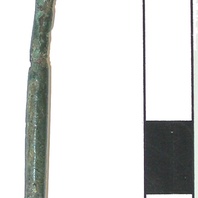
Viking Objects
Expanded-Head Pin (1986/975-AE86)
A copper-alloy pin found at the site of the Little Chester Roman fort. This loose find was found on top of a Roman metalled surface. It has a lozenge-shaped head that is typically Anglo-Scandinavian, but the lack of a secure finds context and its proximity to a Roman surface indicates that it could be Roman.
Read More
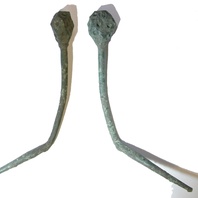
Viking Objects
Ring-and-Dot Pin (1986/976-SF4)
This copper alloy pin with a ring-and-dot pattern on the head was used for fastening cloaks. It was found on the site of Little Chester Roman fort. Pins like this were common in Ireland and the western British Isles, and spread further afield under Viking influence.
Read More
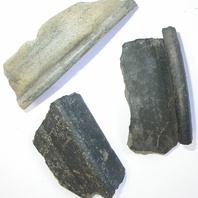
Viking Objects
Early Medieval Pottery Fragments (2001-59)
These are fragments of a Torksey ware rim, decorated Stamford ware rim, and a Stamford ware pot rim. Torksey ware was a type of pottery found in central England and dating to the period ad 850 to 1150. It was manufactured, initially by immigrant potters from Continental Europe, using a fast wheel at workshops around Torksey, Lincolnshire. While not having the same wide geographic distribution as Stamford ware, the popularity of Torksey ware in York was so high that it was initially thought that York was the original location of manufacture. Stamford ware is one of the earliest forms of lead-glazed ceramics in England, being produced in Stamford, Lincolnshire, between the ninth and thirteenth centuries and widely traded across Britain and the near continent. Early Stamford glazes were lead glazes, suggested by some to be unique among early English glazes since they contain traces of silver but not tin. The glaze could be of a pale yellow, orange, pale green, or smoke blue colour and was applied by using a brush.
Read More
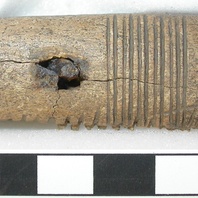
Viking Objects
Antler Comb (1986-976)
Fragments of an antler comb found on the site of Little Chester Roman fort (Derventio Coritanorum) in Derby. This comb is of Anglo-Scandinavian type. It consists of a flat plate of antler sandwiched between two strips of antler that are rounded on the exterior part. The whole is fixed together with an iron rivet. Nicks on the centre plate show that the teeth of the comb were cut after the three plates had been constructed and fixed.
Read More
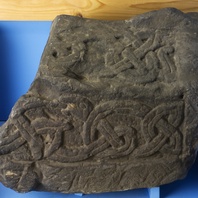
Viking Objects
St Alkmund’s Hogback Grave Marker (1996-60-5)
A stone hogback grave marker from St Alkmund’s Church, Derby. The site of St Alkmund’s Church is thought to have been on one of the oldest Christian sites in the area. Excavations on the site have shown that the church was in existence before the ninth century and that the presence of the Great Army in the ninth century seems to have led to a period of neglect and decay, before it was restored following the reconquest of the Danelaw in the tenth century or early eleventh century. Only about half of this hogback grave cover survives. It has the typical bear at the gable end, although the carving is damaged, and an interlaced serpent design within the panels on the side. It is typical of this type of grave cover which is found throughout northern England and into Scotland. They occur in Viking-dominated areas of the country, and appear to be an Anglo-Scandinavian tradition combining elements of pre-Christian and Christian iconography.
Read More
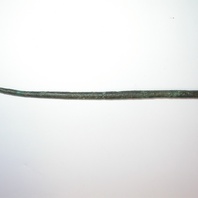
Viking Objects
Ring-headed Pin (1981/166-2568)
This copper alloy ring-headed pin was used for fastening cloaks and discovered during excavations at Full Street, Derby. Pins like this were common in Ireland and the western British Isles, and spread further afield under Viking influence.
Read More
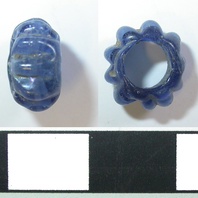
Viking Objects
Blue Glass Bead (2001/59-sf174)
This Viking Age gadrooned or Melon type dark blue glass bead was found in the Magistrates Court excavation in Derby, Derbyshire. Glass beads were a coveted item for making jewellery with some being imported from as far away as the Middle East. They were manufactured by specialised artisans who would heat various coloured glass rods over a furnace and melt the glass onto a metal stick to form different shaped beads.
Read More
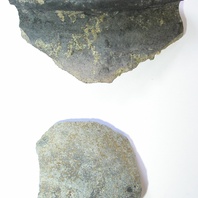
Viking Objects
Early Medieval Pottery (Full Street)
These fragments of early medieval pottery are from Full Street, Derby, a site on the south-eastern corner of the Viking Age town.
Read More
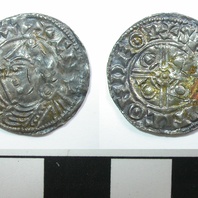
Viking Objects
Silver Penny (1960/459-2)
This silver penny was minted in Derby for King Cnut the Great, the Danish king who reigned over England from 1016-1035. It is not known precisely where it was found. Minting coins was a way of controlling the means of exchange within a kingdom and which created a more easily administered standardized system of trade. Moreover, the coins themselves were often used as propaganda, portaying symbols and statements that gave off a desired message. The Vikings later used the minting of coins to legitimize their own rule.
Read More
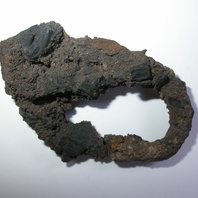
Viking Objects
Iron Buckle (1985/225-3)
An iron buckle from Mound 1 at Heath Wood, Ingleby. The pin of the buckle is bent to one side. This was part of a grave assemblage that include fragments of a sword and other belt fittings.
Read More
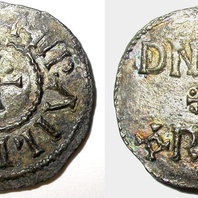
Viking Objects
Viking York Penny (1995-17)
This silver penny was found during demolition work at St Alkmund’s Church in 1967. This type was minted at York for the rulers Sigeferth and Cnut, but this coin has no names, whether of a ruler, a moneyer or a mint. Sigeferth is recorded as being a pirate in Northumbria around 893 and seems to have assumed control after Guthfrith’s death in 895. Cnut is not attested in written sources but Scandinavian tradition places him in Northumbria around the same time. The joint Sigeferth Cnut coins and the sole issues of Cnut were minted around c. 900. This type of penny is known as Mirabilia Fecit from the Latin Cantate Dominum canticum novum, quia mirabilia fecit. Mirabilia fecit means ‘he made it marvellously’ and is the inscription on one side of the coin while the other has the inscription DNS DS REX (‘Dominus Deus rex’ = ‘the lord God almighty is king’).
